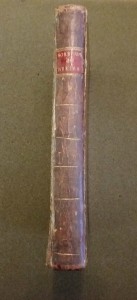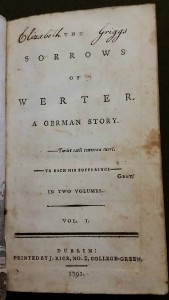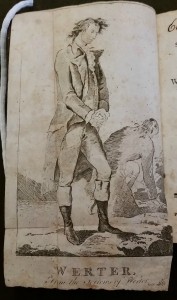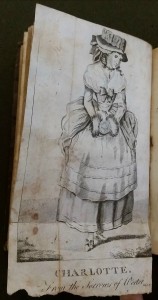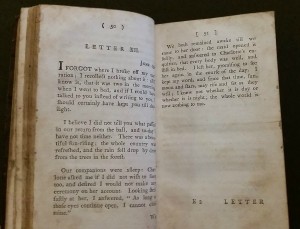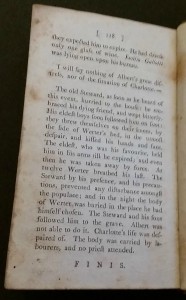The Sorrows of Werter. A German Story, by Johann Wolfgang von Goethe (1791).
Die Leiden des jungen Werthers was first published on September 29, 1774 in German by Weygandsche Buchandlung, Leipzig. It published in English in 1779 and a revised German version of the novel was published in 1787. This is Goethe’s most famous book of his Sturm und Drang (Storm and Stress) period, it is characterized by writing with anti-aristocratic themes, extreme emotions and personal freedom.
The second edition (1775) included some revisions, Goethe prefaced the first and second parts respectively with the two strophes of the poem ‘Jeder Juengling sehnt sich, so zu lieben’ (Every young man longs to love like this), the final lines of which implore the reader in the words of Wether’s ghost: ‘Be a man and do not follow me.’ (Williams 215). It is also probable that the revised version of the novel, published in 1786, was intended by Goethe to correct the public perception of Werther by subtly alienating the reader’s sympathy and hero’s behaviors (Williams 215)
The 50th anniversary edition included a poem from Goethe, ‘An Werther’ (To Werther) is also an occasional poem in the sense that Goethe was prompted to exhume the memory of his youthful hero by the request of the publisher Weygand in 1824 for a dedicatory preface to an edition of the novel celebrating the fiftieth anniversary of its first appearance (Williams 126).
The cover is bound in brown calf skin with the title on red on the binding.
The Sorrows of Young Werther rocked Germany’s literary world when published in 1774, the book quickly sold out, reprints and pirated editions soon followed. Goethe’s writing process of The Sorrows of Young Werther was Sturm und Drang, “I completely isolated myself, even forbade visits by my friends, and I put aside everything internal that did not pertain to this particular situation… Under these circumstances I wrote Werther in four weeks, without previously having put to paper an outline of the whole or a draft of any part of it” (Boerner 30). This book was written quickly and under extreme emotion which is exemplified in the writing style and story. The Sorrows of Young Werther was popular among young people, many dressed like the novel’s protagonists, Werther and Lotte, and it sparked a rise in suicide. In Germany, it became the best-known book after the Bible, yet many were unhappy with this. Members of the bourgeoisie, the clergy and conservative governments recognized the book’s anarchic tendencies and some thought Werther’s attitude represented a threat to the established order (Boerner 31).
This English edition of the Sorrows of Werter was published in 1791 in Dublin, Ireland. This book appeared to have belonged to an Elizabeth Griggs, her name is written on the top of the title page. This is interesting because it was not inside the front cover. This title page is interesting because it does not list Goethe as the author. In fact, he is not mentioned anywhere in the book except in the preface.
THE| SORROWS | OF | WERTER. | A GERMAN STORY | —taedet caeli convexa tueri. | — TO EACH HIS SUFFERINGS — | GRAY | IN TWO VOLUMES | VOL. I | DUBLIN: | PRINTED BY J. RICE, NO. 2, COLLEGE-GREEN. | 1791.
The paper is laid with horizontal chain lines and a watermark on the outside edge that says CASTRES.
Volume I: A-K (starts at A3 ends at K3) 120 pages
Volume II: A-K (starts at A3 ends at K3) 118 pages
Type and page layout:
Roman type.
Title page in black. Drawing on the left side
catchwords:
Head title: The Sorrows of Werter
Running Title: A German Story
Description: to each his sufferings.
This is a twelvemo with 6 pages per leaf and the contents are
A1: Title Page; A2: Title Page of Volume I; A3-A4: “Preface to the London Edition”
A1: Title Page; A2: Title Page of Volume 2.
There is a drawing of Werter on page A2: Volume I it says:
“WERTER. | From the Sorrows of Werter | Vol. II Page 70.”
There is also a drawing Charlotte on page A2: Volume 2, it says,
“CHARLOTTE. | From the Sorrows of Werter | Vol. I Page 24.”
Goethe is mentioned in the preface as “Mr Goethe* (* Doctor of Civil Law, and Author of some musical pieces which are much esteemed).” He is not listed as the author of this book, which is very interesting and odd.
The Sorrows of Werter is an epistolary novel, composed of primarily letters with a brief note from the editor in the middle. Each letter is numbered and some are dated, ex. Letter XII, June 19.
This is the final page of The Sorrows of Young Werter, it says “FINIS.”
Work Cited:
Boerner, Peter. Goethe. London : Haus,, 2005. Print.
Williams, John R. The Life of Goethe : A Critical Biography /. Oxford, UK ; Blackwell Publishers, 2001. Print. Blackwell Critical Biographies.

